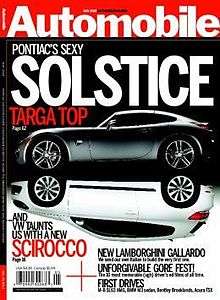
Mitchell (automobile)
Mitchell-Lewis Motor Company was founded in 1900 in Racine, Wisconsin as a motorcycle maker spin-off from the wagon maker Mitchell & Lewis Company Ltd. The company began manufacturing automobiles in 1903. The wagon business and auto companies were combined into Mitchell-Lewis Motor Co. in 1910. The Mitchell car brand produced automobiles from 1903 to 1923.
The Mitchell Lewis Building at 815 Eighth Street in Racine was added to the National Register of Historic Places on April 20, 2005. The Racine architectural firm of Guilbert & Funston is credited with designing the building.
The Mitchell House at 905 South Main Street was owned by Henry Mitchell of the Mitchell Wagon works and was designed by Cecil Corwin.
Originally a carriage builder, the company's first model was a 7hp runabout.Nash Motor Company bought Mitchell-Lewis in 1924.
Mitchell offered four-, six- and eight-cylinder models were built. The 1920 Model E-40 had a rear-sloping radiator which led to the unfortunate nickname of the "Drunken Mitchell". Sales never recovered, and when the company folded in 1923, Nash Motors bought the factory. The company was known for large, fashionable touring cars.
Mitchell
Mitchell may refer to:
People
Places
Australia
Canada
United Kingdom
United States
Mitchell (Surrey cricketer)
Mitchell (first name and dates unknown) was an English professional cricketer.
Career
He was mainly associated with Surrey and he made 2 known appearances in first-class matches from 1803 to 1809.
References
External sources
Mitchell (English cricketer)
Mitchell (first name and details of birth and death unknown) was an English cricketer with possibly amateur status who was active in 1831. He made his first-class debut in 1831 and appeared in one match as an unknown handedness batsman whose bowling style is unknown, playing in a Married v Single match organised by Marylebone Cricket Club (MCC). He scored three runs with a highest score of 3 and took no wickets.
References
Bibliography

Car
A car is a wheeled, self-powered motor vehicle used for transportation and a product of the automotive industry. Most definitions of the term specify that cars are designed to run primarily on roads, to have seating for one to eight people, to typically have four wheels with tyres, and to be constructed principally for the transport of people rather than goods. The year 1886 is regarded as the birth year of the modern car. In that year, German inventor Karl Benz built the Benz Patent-Motorwagen. Cars did not become widely available until the early 20th century. One of the first cars that was accessible to the masses was the 1908 Model T, an American car manufactured by the Ford Motor Company. Cars were rapidly adopted in the United States of America, where they replaced animal-drawn carriages and carts, but took much longer to be accepted in Western Europe and other parts of the world.
Cars are equipped with controls used for driving, parking, passenger comfort and safety, and controlling a variety of lights. Over the decades, additional features and controls have been added to vehicles, making them progressively more complex. Examples include rear reversing cameras, air conditioning, navigation systems, and in car entertainment. Most cars in use in the 2010s are propelled by an internal combustion engine, fueled by deflagration of gasoline (also known as petrol) or diesel. Both fuels cause air pollution and are also blamed for contributing to climate change and global warming. Vehicles using alternative fuels such as ethanol flexible-fuel vehicles and natural gas vehicles are also gaining popularity in some countries. Electric cars, which were invented early in the history of the car, began to become commercially available in 2008.

Automobile (magazine)
Automobile is a United States-based automobile magazine published by TEN: The Enthusiast Network. A group of former employees of Car and Driver led by David E. Davis founded Automobile in 1986 with support from Rupert Murdoch's News Corporation– using the credo No Boring Cars.Automobile distinguishes itself as more of a lifestyle magazine than the other automotive publications, an editorial theme that Davis greatly expanded upon from his tenure as the editor of Car and Driver.
Unlike most other automobile magazines, Automobile does not often do instrumented tests of cars or provide much technical data. Instead, the reviews of vehicles are subjective experiential reports with the cars in their naturally intended, real world environment. Additionally, Automobile reserves a good portion of each issue covering vehicles no longer in production, but still relevant to collectors or automotive history as a whole. For example, the magazine includes features such as "Collectable Classic," an in-depth review of a particular older car, and reports from recent classic and antique car auctions. Automobile also has a regular column by former General Motors designer Robert Cumberford, who analyzes styling elements of current production models and show cars, often linking their design to those of older cars.
Automobile (disambiguation)
An automobile or car is a kind of wheeled motor vehicle. Automobile may also refer to:
Podcasts:

